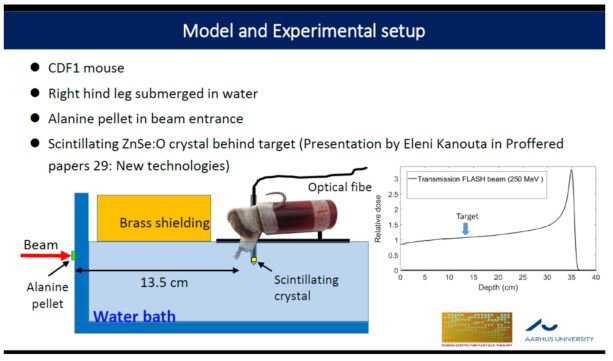Interview with Brita Singers Sorensen, radiobiologist and winner of the Donal Hollywood award. - PDF Version
For this edition of the newsletter of the European SocieTy for Radiotherapy and Oncology (ESTRO), Anthony Chalmers (Chair of Clinical Oncology at the Institute of Cancer Sciences, University of Glasgow, UK) caught up with Brita Singers Sorensen (Danish Centre for Particle Therapy, Aarhus University Hospital, Denmark) to ask her about her radiobiology research in ultra-high-dose-rate radiotherapy (FLASH). Her work was awarded the Donal Hollywood prize for best submitted abstract at ESTRO 2021.
Anthony Chalmers: It's great to see you, and it was also great to see you at the ESTRO meeting in Madrid. First of all, how did you find it, being at a real-life conference?
Brita Singers Sorensen: It was really fantastic! I’ve really missed the the real-life conferences and it was easy to feel that everyone was out for the first time after coronavirus… everyone was a little bit like happy cows in the spring, going back into the field. I really enjoyed it, and it was a very good meeting.
Anthony Chalmers: Absolutely, it was the same for me. But now, many congratulations on winning the Donal Hollywood award for the best abstract at the meeting. Could you tell me briefly what were the main findings of your project?
Brita Singers Sorensen: The main finding of our project was to validate that when you use FLASH with protons you can see the same normal tissue sparing effect as has been seen with electrons. Other papers have validated the normal tissue sparing effect of FLASH protons ‑ the differences in our study were first of all that we used scanning beam FLASH rather than passive beam and that we studied the full dose response to be able to quantify the effect on skin toxicity. We found that a 40-50% higher dose was required in FLASH mode to see the same biological response.
Anthony Chalmers: Why do you think your presentation got so much attention at this meeting?
Brita Singers Sorensen: First of all, right now I think FLASH is a very ‘flashy’ thing! It’s extremely exciting because no one understands what's really going on and everyone thinks if this is really happening, then it could be a real game changer for the clinic. Now we need to supply all the data that shows that it's really a big thing, as it is predicted to be. And for that, we need to systematically look at the normal tissue changes.
Anthony Chalmers: What were the particular challenges about doing the experiments that you needed for the study?
Brita Singers Sorensen: It’s important to emphasise that this is an extremely multidisciplinary study and I was very happy that it ended up in a multidisciplinary session. I'm just providing the biology side of this study; we also have a very good physics team led by Per Poulsen who did all the groundwork in establishing how to deliver FLASH with a proton beam and he did all the validation in my set-up.

Anthony Chalmers: And obviously when you're trying to compare the relative effects of different doses, it's incredibly important to be very confident with the dosimetry; can you tell us how you achieved that?
Brita Singers Sorensen: Yes – the physics team did dosimetry on every single mouse. They placed an alanine pellet in the beam in front of the mouse and they had a scintillation crystal behind the mouse, so we were able to measure the dose delivered to every single mouse.
Anthony Chalmers: The other big issue is: if we are sparing the normal tissues, how do we know we're not sparing the tumour as well?
Brita Singers Sorensen: Yes, we wanted to start with the normal tissue sparing, because if we did not see this there was no reason to continue. Now we're conducting an experiment in the exact same set-up, but we have placed a subcutaneous tumour on the leg. And we're assessing tumour control instead of tumour growth delay, because we think these data are currently missing. We are still doing these experiments, but the preliminary data look very promising.
Anthony Chalmers: Excellent, thank you. How far away are the techniques that you've used to irradiate your mice from what will be needed to treat patients?
Brita Singers Sorensen: That's actually a good question because we place the mouse leg at the entrance of the proton beam, because that's where we can obtain an ultra-high dose rate. But that's not what you optimally want to use in a patient – you want to use a spread out Bragg peak* and currently that is under development.
Anthony Chalmers: So there’s a lot of work still to do on on the delivery of FLASH to patients. Is there anything else you'd like to mention?
Brita Singers Sorensen: I want to acknowledge the group that has been working on these studies, and emphasise that there are a lot of good studies on FLASH ‑ we're just adding to the pool of data.
Anthony Chalmers: That was fun ‑ thank you very much!
* Zoom transcribed this as “split up Brad Pitt”.

Brita Singers Sorensen
Danish Centre for Particle Therapy
Aarhus University Hospital
Aarhus, Denmark

Anthony Chalmers
Wolfson Wohl Cancer Research Centre
Institute of Cancer Sciences
University of Glasgow
Glasgow, UK